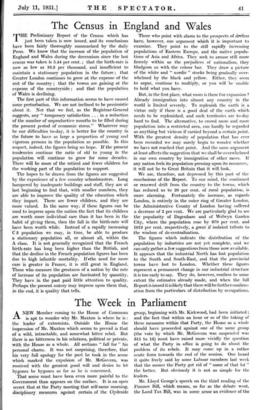The Census in England and Wales rilHE Preliminary Report of
the Census which has I- just been taken is now issued, and its conclusions have been fairly thoroughly summarized by the daily Press. We know that the increase of the population of England and Wales during the decennium since the last Census was taken is 5.44 per cent. ; that the birth-rate is now as low as 16.3 per thousand, and insufficient to maintain a stationary population in the future ; that Greater London continues to grow at the expense of the rest of the country ; that the towns are gaining at the expense of the countryside; and that the population of Wales is declining.
The first part Of this information seems to have caused some perturbation. We are not inclined to be pessimistic about it. Not that we feel, as the Registrar-General suggests, any "temporary satisfaction. . . in a reduction Of the number of unproductive mouths to be filled during the present period of economic stress." Whatever may be our difficulties to-day, it is better for the country in the future to have as large a proportion of young and vigorous persons in the population as possible. In this respect, indeed, the figures bring no hope. If the present tendencies continue the ratio of old to young in the 'population will continue to grow for some deeades. There will be more of the retired and fewer children for the working part of the population to support.
The hopes to be drawn from the figures are suggested by the experience of a few country schoolmasters. Long hampered by inadequate buildings and staff, they are at last' beginning to find that, With smaller numbers, they are able' to improve the quality of the education which they impart. There are fewer children, and they are More valued. In the same way, if these figures can be • Used to impress upon the nation the fact that its children are worth more individual care than it has been in the habit of giving them, then the fall in the birth-rate will have been worth while. Instead of a rapidly increasing C 3 population we may, in time, be able to produce a stationary population all, or almost all, within . the A class. It is not generally recognized that the French birth-rate has long been higher than the British, and that the decliiae in the French population figures has been due to high infantile mortality. If 'the need for more care is greater in France, it . is still great in England. Those who measure the greatness of a nation by the rate of increase of its population are fascinated by quantity. They have in the past paid little attention to quality. Perhaps the present outcry May impress upon them that, iii theend, it is quality that tells. Those who point with alarm to the prospects of decline have, however, one argument which it is important to examine. They point to the still rapidly increasing populations of Eastern Europe, and the native popula- tions of Asia and Africa. They seek to amuse still more fiercely within us the prejudices of nationalism, they bludgeon us with the colour bar. They draw a picture of the white and " nordic " stocks being gradually over- whelmed by the black and yellow. Either, they seem to argue, continue to multiply, or you will be unable to hold what you have.
But, in the first place, what room is there for expansion ? Already immigration into almost any country in the world is limited severely. To replenish the earth is a virtue only if there is a good deal of the earth which needs to be replenished, and such territories are to-day hard to find. The alternative, to crowd more and more population into a restricted area, can hardly be regarded as anything but vicio us if carried beyond a certain point. With the greatest density of population that has ever been recorded we may surely begin to wonder whether we have not reached that point. And the same argument at least affects the suggestion that we shall be overwhelmed in our own country by immigration of other races. If any nation feels its population pressing upon its resources, it will not be to Great Britain that it will look.
We are, therefore, not depressed by this part of the conclusions of the Report. To our mind, the continued or renewed drift from the country to the towns, which has reduced us to 20 per cent. of rural population, is more alarming. Fortunately the increase, as regards London, is entirely in the outer ring of Greater London, the Administrative County of London having suffered a decrease of 2 per cent. We are particularly glad to see the popularity of Dagenham and of Welwyn Garden City, where the population rase by 879 per cent. and 1019 per cent, respectively, a great if isolated tribute to the wisdom of de-centralization.
The figures which indicate the distribution of the population by industries are not yet complete, and we can only gather a few suggestions from those now available. It appears that the industrial North has lost population to the South and South-East, and that the provincial towns have lost to London. Whether these figures represent a permanent change in our industrial structure it is too early to say. They do, however, confirm to some extent the estimates already made, and when the full Report is issued it is likely that there will be further confirm- ation from the particulars of distribution by occupations.


































 Previous page
Previous page